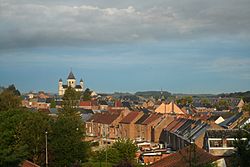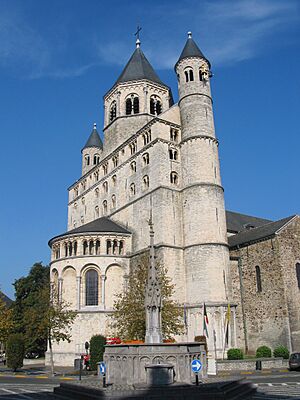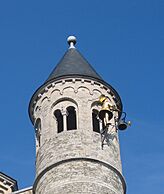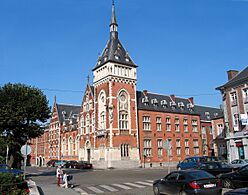Nivelles facts for kids
Quick facts for kids
Nivelles
Nivele (Walloon)
Nijvel (Dutch)
|
|||
|---|---|---|---|
 |
|||
|
|||
| Country | Belgium | ||
| Community | French Community | ||
| Region | Wallonia | ||
| Province | Walloon Brabant | ||
| Arrondissement | Nivelles | ||
| Area | |||
| • Total | 60.60 km2 (23.40 sq mi) | ||
| Population
(2018-01-01)Lua error in Module:Wd at line 1575: attempt to index field 'wikibase' (a nil value).
|
|||
| • Total | Lua error in Module:Wd at line 1,575: attempt to index field 'wikibase' (a nil value). | ||
| Postal codes |
1400, 1401, 1402, 1404
|
||
| Area codes | 067 | ||
| Website | www.nivelles.be | ||
Nivelles is a city and municipality in Wallonia, a region in Belgium. It is located in the Walloon Brabant province. The municipality of Nivelles includes smaller areas like Baulers, Bornival, Thines, and Monstreux.
The entire Walloon Brabant province is part of the Nivelles area. The famous Collegiate Church of St. Gertrude in Nivelles is a protected heritage site in Wallonia.
Contents
History of Nivelles
Early Days and Growth
Around 4,000 BC, people called Danubian settlers started farming in the Nivelles area. Later, in the first century AD, the Romans arrived and built many villas. However, these Roman buildings were destroyed during invasions by Germanic peoples in the 3rd century.
In the 7th century, Nivelles was part of the Frankish kingdom. A powerful leader named Pippin of Landen built a large estate there. After Pippin died in 640, his wife, Itta, was encouraged to start an abbey (a type of monastery) on their land.
Their daughter, Gertrude, became the first leader (abbess) of this monastery. She was later recognized as a saint. Many people visited the monastery, which led to bigger churches being built. The biggest one, a huge Romanesque church, still stands today. It was officially opened in 1046. This was a very successful time for the Nivelles monastery, which owned land far away.
From the 13th Century to 1830
By the 13th century, a city grew around the church. Nivelles became part of the Duchy of Brabant. Many people in the city were skilled workers and members of guilds (groups of craftsmen). They often fought with the abbesses and dukes to gain more rights for themselves.
These rights were finally given to them in the 14th century. In 1647, many thread makers left the city after a big protest. This caused the city's economy to decline. Wars in the 17th century also made things worse, as Nivelles was attacked and occupied many times.
From 1830 to Today
In 1830, Nivelles was one of the first cities to send soldiers to Brussels to fight in the Belgian Revolution. After this, the city saw growth in heavy industry, like metalworking and building railways.
During World War I, some buildings were damaged. But much greater destruction happened on May 14, 1940, during World War II. Almost the entire city center was destroyed, and only the walls of the collegiate church remained. The church was rebuilt and finished in 1984.
Main Places to See
- The Collegiate Church of St. Gertrude is a very old church. It was built between the 11th and 13th centuries. It is a great example of Romanesque style and is considered an important heritage site in Europe. Underneath the church, tombs from the 7th and 9th centuries have been found. Its Romanesque crypt (an underground room) is one of the largest in Europe.
- A two-meter-tall statue called "Jean de Nivelles" strikes the hours on one of the church towers. This statue is very old, dating back to around 1400.
- The Recollets convent and its church were built in the 16th century.
- Nivelles also has an archaeological museum. It helps visitors learn more about the history of the area and the Saint Gertrude church.
- The "Dodaine" park is a lovely green space on the south side of the town.
Fun Traditions and Folklore
- Like the city of Ath, Nivelles has a collection of giant figures used in parades. One of them, Goliath, dates back to 1365! The Goliath family (husband, wife, and son) often parades with giant animals like a lion, a camel, a unicorn, and a dragon.
- The Saint-Gertrude religious procession is a popular event that started in the 13th century. It happens every year.
- The Nivelles Carnival is a more recent tradition from the 19th century. It takes place on the first weekend of Lent. Like the Binche Carnival, Nivelles' carnival features the famous Gilles characters.
- A special food from Nivelles is the tarte al d'jote. It's a type of quiche made with local cheese, onions, greens, eggs, and butter.
- Nivelles is also known for its carillon, which is a musical instrument made of 49 bells.
Sports in Nivelles
In 1972 and 1974, the Belgian Grand Prix car race was held at the Nivelles-Baulers circuit. The famous driver Emerson Fittipaldi won both races. However, the track was not very popular and has since been taken down.
In September 2007, Nivelles helped host the VII European Handball Championship. This event included different types of handball games.
Famous People from Nivelles
- St Wilfretrudis of Nivelles – An abbess and niece of Gertrude (7th century).
- Pippin of Landen – A powerful leader under the Merovingian kings (7th century).
- Gertrude of Nivelles – Pippin's daughter and the first abbess of the Nivelles monastery (626–659).
- Johann Tserclaes – A general in the Holy Roman Empire during the Thirty Years' War (1559–1632).
- Louis-Joseph Seutin – A well-known doctor and surgeon (1793–1862).
- Jules Louis Guillery – A lawyer and politician (1824–1902).
- Henri Delmotte – A novelist (1822–1884).
- Didier Theys – A racing driver (born 1956).
- André Lotterer – Another racing driver (born 1981).
- Ange de Nivelles – A Capuchin friar in the 1600s.
Twin City
See also
 In Spanish: Nivelles para niños
In Spanish: Nivelles para niños








